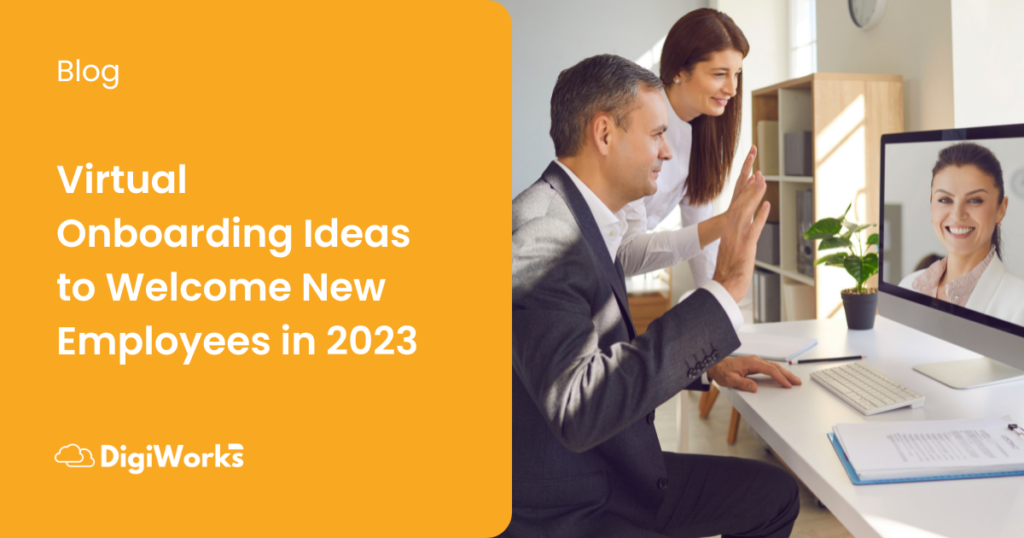Virtual Onboarding Ideas to Welcome New Employees in 2023
Aug 20, 2024 • 18 min read

Welcome to the new year of 2023, where remote work and virtual onboarding have become the norm. With more companies embracing remote work, hiring remote employees has also become a common trend. For this reason, it is essential to have a comfortable and welcoming virtual onboarding program for new employees.
Virtual onboarding programs require creativity, innovation, and planning to make the onboarding experience effective and worthwhile. By leveraging these virtual onboarding ideas, companies can maintain effective onboarding processes and engage remote employees just as they would in a physical office.
You’ll learn:
- List of Virtual Onboarding Ideas
- How To Welcome A New Employee Virtually
Ready to build your remote team?
Use the DigiWorks platform to hire, manage, and pay remote talent from all over the world.
List of Virtual Onboarding Ideas
In today’s digital age, many companies are transitioning to remote work arrangements, and with that, comes a need for new and innovative ways to onboard remote employees. Fortunately, there are plenty of exciting virtual onboarding ideas that companies can implement to make the process efficient and engaging.
1. Online organizational chart
One useful tool for onboarding remote employees is an online organizational chart. When a new employee joins a company, they often struggle to understand the hierarchy and who they should be communicating with for various tasks or questions. An online organizational chart can help alleviate this confusion by providing an easily accessible visual representation of the company’s structure.
The chart is typically organized in a hierarchical layout, with the CEO or top executive at the top, followed by other executives, managers, and individual contributors. Each employee is listed with their job title, department, and contact information, making it easy for new hires to find the person they need to speak with.
The online organizational chart can be further enhanced by adding additional information about each employee, such as their job description, responsibilities, and projects they are working on. This can give new hires a deeper understanding of the company’s organizational structure and how each department contributes to the company’s success.
In addition to aiding in onboarding, an online organizational chart can also help in employee engagement and retention. Employees can use the chart to identify potential career paths within the company and see who they may need to network with to reach their goals. It can also help foster a sense of community within the company as employees become more familiar with each other’s roles and responsibilities.

2. Grand entrance announcement
The grand entrance announcement is one of the most exciting parts of the onboarding process. This is the moment when a new remote employee is officially welcomed to the team and introduced to all of their colleagues. It’s an opportunity to make a great first impression and set the tone for the entire onboarding experience.
There are a few key elements that make a grand entrance announcement truly memorable. First and foremost, it should be personalized to the new hire. This means including their name and a brief overview of their background and experience. It’s also a good idea to highlight any unique skills or talents they possess that will add value to the team.
Another important element of a grand entrance announcement is the delivery. This should be an exciting and engaging moment that gets everyone on the team excited to meet the new hire. It’s a good idea to plan ahead and think about how you want to introduce the new employee. This might involve setting up a virtual stage or creating a personalized video message that can be shared with the team.
Finally, it’s important to follow up the grand entrance announcement with other activities and events that help the new hire feel welcome and included. This might include one-on-one meetings with team members, virtual coffee breaks, or even a fun scavenger hunt that helps the new hire get to know their colleagues better.
3. Digital new member lounge and library
One of the most effective ways to onboard remote employees is by creating a digital new member lounge and library. This resource provides new hires with access to important information, policies, and procedures. It also helps new hires feel more connected to the company and the rest of the team, even when they’re working remotely.
The digital new member lounge and library should include a variety of resources. This might include an employee handbook, an organizational chart, and information on the company’s culture and history. Additionally, the library should include training materials, such as videos and webinars, that can help new hires get up to speed quickly.
One of the key benefits of a digital new member lounge and library is that it’s accessible from anywhere. This means that new hires can access the resources they need at any time, whether they’re working from home or on the go. It also makes it easy for remote teams to stay up to date on the latest policies and procedures, regardless of where they’re located.
When creating a digital new member lounge and library, it’s important to make it user-friendly and easy to navigate. This might involve using a simple layout, organizing resources by category, and including search functionality. It’s also a good idea to incorporate multimedia, such as videos and graphics, to make the content more engaging.

4. New hire survival kits
As part of a virtual onboarding program, creating new hire survival kits is a great way to make remote employees feel welcome and engaged with the company culture. These kits can include a variety of items, both practical and fun, that help employees feel prepared and appreciated as they begin their new role.
One item that can be included in the kit is a company-branded water bottle. This both encourages healthy hydration and promotes team spirit. Another practical item is a personal work from home kit that includes noise-canceling headphones, an ergonomic mouse and keyboard, and a plant to brighten up their workspace. This shows that the company values the well-being and comfort of its employees.
For a fun touch, consider including a company t-shirt or hat that employees can wear during video conferences or casual Fridays. Small snacks or treats can also be included in the kit for when they need a pick-me-up during the workday, such as granola bars or gourmet popcorn.
Including a personalized note from their manager or onboarding buddy can also go a long way in making remote employees feel connected and valued. The note can welcome them to the team and offer support as they start their new role. This personal touch can start building strong connections and increase employee engagement from the very start.
5. Brand new buddy calls
When it comes to onboarding remote employees, having a designated “buddy” for new hires can make a huge difference in their experience. But what if instead of just one buddy, new employees were assigned to a group of brand new buddies who are also starting their roles at the same time?
Brand new buddy calls can be a valuable addition to your remote onboarding program. By fostering community, encouraging collaboration, creating accountability, increasing engagement and improving retention, your new hires will have a more positive and effective onboarding experience.

6. Remote team welcome lunch
If you’ve ever started a new job, you know how nerve-wracking it can be to meet a team of strangers for the first time. This feeling is only amplified when onboarding remotely, without any in-person interactions. That’s why offering a remote team welcome lunch can be a great way to break the ice and make new hires feel more comfortable.
A remote team welcome lunch can be conducted virtually, giving new employees the chance to interact with their team in a more relaxed setting. It provides an opportunity for informal conversations and getting to know one another outside of scheduled meetings. Plus, who doesn’t love a good meal shared with others?
To organize a remote team welcome lunch, you can send out food delivery gift cards to your new hires. It’s important to make sure everyone can order something from a local restaurant or delivery service that caters to their dietary restrictions, so everyone feels included.
To keep the conversation flowing during the lunch, you can provide discussion prompts or icebreakers for employees to share their interests, hobbies, backgrounds, and other personal details. This can help employees feel more connected to each other and establish personal connections.
7. Ties that bind
When it comes to onboarding remote employees, one of the biggest challenges is establishing strong connections and fostering a sense of belonging within the team. This is particularly challenging when you can’t rely on in-person interactions to build relationships.
Fortunately, there are several strategies that you can use to build ties that bind within your virtual team. These strategies focus on creating opportunities for personal connections, as well as finding ways to connect remote employees with the broader organizational culture.
Onboarding remote employees requires a thoughtful approach that prioritizes building community and connecting individuals to the broader organization. Through strategies such as virtual coffee breaks, one-on-one meetings, and employee welcome kits, remote employees can establish the kinds of strong ties that are essential for creating a happy and engaged workforce.

8. Online welcome scavenger hunt
One fun and engaging way to onboard remote employees is to organize an online welcome scavenger hunt specifically designed for new hires. This game can be a great icebreaker and help new employees feel welcomed and valued as part of the team.
To start, create a list of tasks for the scavenger hunt that are creative and fun, but also educational about the company culture and values. You might include questions like “What’s the company’s mission statement?” or “What’s the name of the CEO?”
To encourage social interaction, consider creating team challenges that require new hires to work with other team members. For example, a challenge could be to create a group selfie that includes everyone in the team.
Make sure to include a prize for the winning team, such as a gift card or company-branded merchandise, to add an element of friendly competition and motivation.
By participating in this scavenger hunt, new hires would feel an immediate sense of team camaraderie and fun, while also learning more about their colleagues and the company they represent. Moreover, this scavenger hunt would help new hires feel more confident, easing their transition into their new role.

How To Welcome A New Employee Virtually
As companies shift to remote work arrangements due to the ongoing global pandemic, the process of onboarding new employees has undergone a significant transformation. Whereas before, welcoming new hires would involve physical introductions to colleagues, an office tour, and personal interactions, virtual onboarding has become the new normal.
Fortunately, there are many creative and effective ways to welcome your new employee virtually and ensure that they feel engaged and connected from day one. Here are some ideas on how to make virtual onboarding a successful experience for both the employer and new hire:
Step 1: Have An Introductory Call
When it comes to onboarding remote employees, one of the most important steps is to have an introductory call. This call is the first interaction with your new hire and sets the tone for the rest of the onboarding process.
During the introductory call, you should take some time to get to know your new employee. Ask about their background, their goals, and what they hope to achieve in their new role. This is also a good time to review the onboarding plan and provide an overview of the company culture and values.
It’s important to remember that remote employees may feel isolated or disconnected, especially during the onboarding process. By taking the time to have an introductory call, you demonstrate that you value their contributions and are committed to their success.
To make the most of your introductory call, be sure to prepare in advance. Make a list of questions you want to ask and review the employee’s resume and application. This will help you better understand their experience and qualifications, and make the call more productive.
Another way to make the call more effective is to schedule it during a time when both you and the new employee are free from distractions. This will help ensure that you can have a meaningful conversation and make the employee feel valued and appreciated.
Ready to build your remote team?
Use the DigiWorks platform to hire, manage, and pay remote talent from all over the world.
Step 2: Meet The Team
After the introductory call, it’s time to introduce your new remote employee to the rest of the team. This is an important step in the onboarding process as it helps create a sense of belonging and makes the employee feel like they are part of the team.
There are several ways to make introductions, depending on the size and structure of your remote team. One option is to schedule a virtual meeting where everyone can introduce themselves and share a bit about their role and experience at the company. This can be done using video conferencing software like Zoom or Skype.
Another option is to set up one-on-one meetings between the new employee and their team members. This can be especially effective for larger teams where it might be difficult for everyone to share in a group setting. These meetings can be scheduled over a series of days or weeks, depending on the availability of your team members.
It’s also a good idea to assign an onboarding buddy to the new employee. This person can serve as a mentor and help them navigate the company and their role. Ideally, this person should be someone who has been with the company for a while and has a good understanding of the culture and values.
In addition to introductions, it’s important to provide your new employee with an employee handbook or other resources that outline company policies and procedures. This will help them understand what is expected of them and what they can expect from the company.

Step 3: Icebreakers And Games
Bringing on remote employees can be a challenge, particularly if you’re not able to meet them in person. But virtual onboarding doesn’t have to be impersonal or dull. In fact, this is an opportunity to get creative and have some fun with the process.
One effective way to make your new remote employees feel at home is to incorporate icebreakers and games into their onboarding experiences. Not only do these activities encourage team building and communication, they also provide a welcome break from the more formal aspects of the onboarding process.
There are plenty of remote-friendly icebreaker ideas out there. For example, you might try a virtual scavenger hunt, where employees race to find and take photos of various items around their home offices. Or you might lead a round of virtual Pictionary or charades, letting everyone showcase their artistic or dramatic talents.
Another popular option is to have everyone introduce themselves and share a fun fact about themselves. This could be anything from “I’m an avid collector of vintage lunch boxes” to “I once backpacked solo across Europe for three months.” Not only is this a great way to learn about each other’s interests, it can also lead to some inspiring conversations and connections.
Of course, icebreakers and games don’t have to be purely for entertainment purposes. You can also use these activities as a chance to impart important information and create opportunities for productive discussions. For example, you might ask everyone to share their thoughts on a company mission statement or a recent industry article.

Step 4: Start With The Broad Strokes
When it comes to onboarding remote employees, it’s important to start with the big picture before getting into the nitty-gritty details. This means beginning with the broad strokes of your onboarding process, such as overall goals, timelines, and key milestones.
As you start planning out your remote onboarding process, consider what you want your new employees to accomplish in the first few weeks and months on the job. This might include learning about company culture, meeting key teammates, getting up to speed on company tools and software, and familiarizing themselves with the company’s mission and vision.
Once you have a clear idea of your onboarding goals, you can start building out a rough timeline of when these milestones should be achieved. For example, you might plan for the first week to be focused on orientation and introductions, with the second week devoted to more in-depth training and meetings with team leads.
As you develop your timeline, be sure to think realistically about how much time your new hires will need for each task. You don’t want to overload them with too much information or too many meetings all at once, but you also don’t want to leave them without enough to do.
It can be helpful to involve existing employees in the planning process, as they may have insights into what worked (and what didn’t) in previous onboarding experiences. You may also want to consider having an onboarding buddy assigned to each new hire, someone who can answer questions and provide guidance as needed.

Step 5: Explain, Explain, Explain
When it comes to the onboarding process for remote employees, it’s crucial to provide clear and thorough explanations for every aspect of the job. From company policies to software tools, new hires need to understand how everything works in order to succeed in their roles.
One key area to explain is company culture. This includes the company’s mission, values, and expectations for behavior and communication. By explaining these elements of culture, new hires can understand how they fit into the company and what is expected of them.
Another important area to explain is software and other tools used by the company. This might include project management software, communication tools like Slack, or other technology that is critical to the job. Be sure to explain how each tool works and provide ample training to ensure your employees are comfortable using them.
Onboarding also provides an opportunity to explain company policies, such as employee benefits, code of conduct, and security procedures. Explain these policies clearly so that employees understand what is expected of them and what they can expect from the company.
It’s also important to explain how employees can reach out for help or support if they need it. This might include contact information for their manager or HR representative, as well as any employee resources like counseling services or wellness programs.
Step 6: End The Day With Joy
When it comes to remote work, it can be easy to blend work and personal time together, which can lead to burnout and difficulty in finding work-life balance. Therefore, it’s essential to create a clear separation between work and personal time. One way to do this is to practice ending your workday with joy.
Ending your workday on a positive note can have numerous benefits, including increased productivity, satisfaction, and overall job performance. Here are a few tips to help you cultivate joy at the end of your workday:
Ending your workday on a positive note can significantly impact your well-being, motivation, and job satisfaction. By setting a routine, celebrating your accomplishments, engaging in a relaxing activity, connecting with loved ones, and practicing gratitude, you can create daily moments of joy that will have a ripple effect on your overall happiness and success.

Conclusion
In any piece of writing, the conclusion is the final opportunity to leave a lasting impression on the reader. It’s the part of the piece that ties all of the ideas together and provides a sense of closure. A strong conclusion should be memorable, impactful, and leave the reader with something to think about.
One of the most important elements of a conclusion is to reiterate the main points of the piece in a succinct and powerful way. This helps to reinforce the key themes and ideas presented in the piece, and reminds the reader of the important takeaways.
To take the conclusion to the next level, it can be helpful to add something new or unexpected that ties back to the opening of the piece. This can help to add a sense of circularity and completeness to the writing, and give the reader a sense of satisfaction and closure.
Ready to build your remote team?
Use the DigiWorks platform to hire, manage, and pay remote talent from all over the world.
About DigiWorks
DigiWorks is an easy-to-use platform that helps small businesses and start ups hire amazing remote talent from around the world. DigiWorks offers a way for you to hire, manage and pay people from all countries. If you find an amazing virtual assistant from Philippines, a content writer from Nigeria, or operations manager from South Africa – manage and pay your entire team from one platform with no hassle.
If you’re looking for a more affordable and sustainable option you might consider making use of a hiring platform like DigiWorks. Virtual assistant companies or platforms like DigiWorks are amazing as they not only match you with pre-vetted and assessed remote workers that can take care of all your business needs but they will also handle all onboarding and payroll needs as well.



